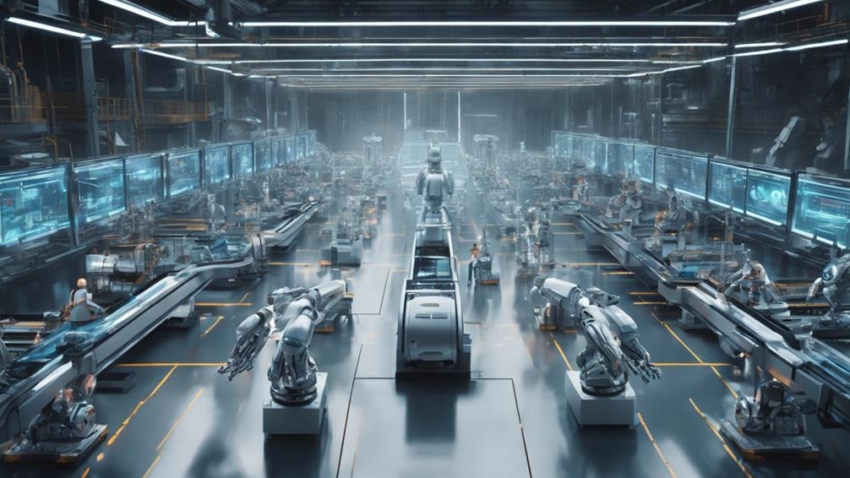
Advanced Robotics: Transforming Operations in Manufacturing
Advanced robotics is transforming manufacturing operations by automating repetitive tasks, enhancing quality control, and increasing production flexibility. This results in significant cost savings and improved productivity. Robots are designed to work alongside humans, freeing up workers to focus on high-value tasks. The fusion of AI, machine learning, and IoT is creating smart factories that can predict and prevent equipment failures, optimize production workflows, and respond swiftly to market changes. As manufacturers continue to harness the power of advanced robotics, they will uncover even more innovative ways to streamline operations, drive efficiency, and stay ahead of the competition.
Robots in Manufacturing: A New Era
As the manufacturing landscape continues to shift towards increased automation, robots are stepping into the fray, revolutionizing production lines and signaling the dawn of a new era in industrial production. This transformation is not only about efficiency and productivity but also about the ethics surrounding the integration of robots in manufacturing. The concept of Robot Ethics is becoming increasingly relevant as machines are taking on more autonomous roles, raising questions about accountability, responsibility, and potential biases.
The evolution of manufacturing is being driven by the need for precision, speed, and adaptability. Robots are being designed to work alongside humans, augmenting their capabilities and freeing them from repetitive tasks. This collaboration enables manufacturers to focus on high-value tasks, driving innovation and competitiveness. The Manufacturing Evolution is characterized by the fusion of artificial intelligence, machine learning, and the Internet of Things (IoT), creating smart factories that can respond to changing market demands in real-time.
As robots assume more prominent roles in manufacturing, it is essential to establish guidelines and frameworks that ensure their deployment is ethical, transparent, and accountable. By doing so, manufacturers can reap the benefits of automation while maintaining the trust and confidence of their customers and stakeholders. By embracing this new era in industrial production, manufacturers can access new opportunities for growth, innovation, and competitiveness.
Automation of Repetitive Tasks
One of the most significant advantages of automation in manufacturing is the ability to assign robots to perform repetitive tasks, freeing human workers from mundane and potentially hazardous duties. This allows for Task Simplification, enabling workers to focus on higher-value tasks that require creativity, problem-solving, and critical thinking. By automating repetitive tasks, manufacturers can optimize their processes, reduce errors, and increase productivity.
| Task | Automation Benefit | Outcome |
|---|---|---|
| Assembly | Increased precision and speed | Improved product quality |
| Inspection | Enhanced accuracy and detection | Reduced defects and waste |
| Material Handling | Efficient and safe transportation | Reduced labor costs and injuries |
Automation of repetitive tasks also enables Process Optimization, allowing manufacturers to streamline their operations and eliminate inefficiencies. By analyzing production data and identifying areas for improvement, manufacturers can fine-tune their processes, reduce waste, and increase overall efficiency. With robots handling repetitive tasks, manufacturers can redirect their resources to more strategic initiatives, driving innovation and growth. By embracing automation, manufacturers can transform their operations, improve product quality, and gain a competitive edge in the market.
Reducing Production Costs Efficiently
By automating repetitive tasks, manufacturers can redirect their resources to optimize production processes, ultimately leading to significant cost savings and improved operational efficiency. This redirection of resources enables manufacturers to focus on high-value tasks, such as cost analysis and supply optimization. By conducting a thorough cost analysis, manufacturers can identify areas of inefficiency and allocate resources more effectively, resulting in reduced production costs.
Advanced robotics plays an important role in supply optimization by streamlining inventory management and logistics. By leveraging robotics to manage inventory levels, manufacturers can minimize waste, reduce stockouts, and optimize supply chain operations. This, in turn, leads to reduced production costs and improved operational efficiency. Additionally, robotics-enabled supply optimization enables manufacturers to respond quickly to changes in demand, ensuring that production is aligned with market needs.
Improving Product Quality Control
As manufacturers work to maintain a competitive edge, the importance of ensuring product quality cannot be overstated. Advanced robotics in manufacturing offers a solution to this challenge through the integration of defect detection systems and automated inspection tools. By leveraging these technologies, manufacturers can greatly enhance product quality control, reducing the likelihood of defects and improving overall customer satisfaction.
Defect Detection Systems
Defect detection systems, an essential component of advanced robotics in manufacturing, have revolutionized product quality control by enabling the swift identification and elimination of flaws in real-time. These systems utilize Machine Vision, a technology that empowers robots to visually inspect products and detect defects with precision. By leveraging Machine Vision, manufacturers can guarantee that only flawless products reach the market, thereby enhancing customer satisfaction and brand reputation.
Predictive Maintenance is another vital aspect of defect detection systems. By analyzing real-time data from sensors and machines, these systems can forecast when equipment is likely to fail, allowing for proactive maintenance and minimizing downtime. This results in increased productivity, reduced costs, and improved overall efficiency. Moreover, defect detection systems can be integrated with other advanced robotics technologies, such as robotic arms and conveyor systems, to create a seamless and efficient manufacturing process. By adopting defect detection systems, manufacturers can achieve unparalleled levels of quality control, ensuring that their products meet the highest standards of excellence.
Automated Inspection Tools
Automated inspection tools have emerged as a cornerstone of advanced robotics in manufacturing, building upon the foundations of defect detection systems by providing a more granular level of quality control through precise and efficient product examination. By leveraging computer vision and machine learning algorithms, these tools enable manufacturers to scrutinize products with unprecedented accuracy, detecting even the slightest deviations from specified standards. Additionally, sensor calibration guarantees that inspection tools are finely tuned to detect anomalies, allowing for swift corrective action to be taken. This results in significant reductions in waste, rework, and ultimately, improved product quality. In addition, automated inspection tools facilitate real-time data analysis, enabling manufacturers to identify patterns and trends that inform process improvements and optimize production workflows. By integrating these tools into their operations, manufacturers can exert greater control over product quality, driving business growth and competitiveness in the process.
Increased Flexibility in Production
As the manufacturing landscape continues to evolve, the need for flexibility in production has become increasingly paramount. Advanced robotics offers a solution to this challenge by enabling adaptive production schedules that can quickly respond to changes in demand or production requirements. By efficiently allocating resources and adjusting production workflows in real-time, manufacturers can greatly enhance their ability to adapt to shifting market conditions.
Adaptive Production Schedules
By dynamically adjusting production schedules in response to changing demand or supply chain disruptions, manufacturers can greatly reduce downtime and increase overall efficiency. This adaptive approach enables production lines to respond swiftly to shifting market conditions, ensuring that output remains aligned with actual demand. Through advanced robotics, manufacturers can leverage dynamic scheduling to optimize production workflows, minimizing idle time and maximizing resource utilization.
To achieve this level of agility, manufacturers must invest in sophisticated production forecasting tools that provide accurate and real-time insights into demand patterns. By integrating these tools with dynamic scheduling systems, production teams can respond proactively to changes in demand, adjusting production schedules to meet shifting requirements. This fusion of advanced robotics and data-driven insights enables manufacturers to achieve unprecedented levels of flexibility and responsiveness, ultimately leading to improved productivity, reduced waste, and enhanced customer satisfaction.
Efficient Resource Allocation
Maximizing resource allocation is critical to achieving the flexibility needed to respond to shifting demand patterns, and advanced robotics play a key role in this process by enabling the dynamic redeployment of resources. By leveraging advanced robotics, manufacturers can enhance their resource allocation in real-time, guaranteeing that resources are utilized efficiently and effectively. This is particularly important in today's fast-paced production environment, where adaptability and responsiveness are essential for staying competitive.
Advanced robotics facilitate best staffing by identifying areas where labor can be redeployed to maximize productivity. This ensures that the right personnel are assigned to the right tasks, minimizing waste and maximizing output. Additionally, advanced robotics enable resource optimization by streamlining production workflows, reducing downtime, and improving overall equipment effectiveness. By integrating advanced robotics into their operations, manufacturers can achieve significant improvements in productivity, quality, and cost savings, ultimately leading to increased competitiveness and profitability.
Real-Time Production Monitoring Systems
In modern manufacturing facilities, real-time production monitoring systems play a pivotal role in guaranteeing seamless operations by providing instant visibility into production processes and enabling swift response to disruptions. These systems empower manufacturers to exercise precise control over production, allowing them to identify and rectify inefficiencies in real-time. By leveraging advanced data analytics, manufacturers can gain valuable insights into production trends, bottlenecks, and areas of improvement. This enables process optimization, as data-driven decisions can be made to streamline operations, reduce waste, and increase productivity.
Real-time production monitoring systems also facilitate proactive maintenance, enabling manufacturers to schedule maintenance during planned downtime, minimizing equipment failure and reducing costly repairs. Moreover, these systems enable manufacturers to monitor production quality in real-time, allowing for swift corrective action in the event of deviations from quality standards. This ensures consistent product quality, reducing the likelihood of costly rework and enhancing customer satisfaction. By integrating real-time production monitoring systems with advanced robotics, manufacturers can achieve unparalleled levels of operational efficiency, precision, and control. As the manufacturing landscape continues to evolve, the importance of real-time production monitoring systems will only continue to grow, driving the adoption of advanced robotics and data-driven manufacturing practices.
Enhanced Supply Chain Management
Advanced robotics in manufacturing also enables enhanced supply chain management, as real-time data exchange and analytics facilitate the orchestration of complex logistics, ensuring just-in-time delivery and minimizing inventory costs. This level of precision and control allows manufacturers to respond swiftly to changes in demand, thereby achieving Supply Chain Agility. By leveraging advanced robotics, manufacturers can optimize their inventory levels, reducing waste and excess stock, and ensuring that production is aligned with actual demand. This Inventory Optimization leads to significant cost savings and improved profitability.
Moreover, advanced robotics enables the creation of a digital twin of the supply chain, providing a real-time virtual replica of the physical supply chain. This digital twin enables manufacturers to simulate different scenarios, predict potential disruptions, and make data-driven decisions to mitigate risks. With advanced robotics, manufacturers can proactively manage their supply chain, responding to changes in demand and mitigating the risk of stockouts or overstocking. By integrating advanced robotics into their supply chain management, manufacturers can achieve a new level of control, precision, and agility, ultimately leading to improved customer satisfaction and competitiveness in the market.
Streamlining Warehouse Operations
By leveraging advanced robotics in manufacturing, warehouse operations can be streamlined through the automation of tasks such as inventory tracking, order fulfillment, and shipping, allowing for increased efficiency and reduced labor costs. This transformation is made possible by the integration of robotics in warehouse operations, enabling the optimization of inventory management and warehouse layout.
Advanced robotics enables real-time inventory tracking, ensuring accurate stock levels and minimizing stockouts or overstocking. This precision inventory management allows for better forecasting and planning, reducing the need for manual intervention and minimizing errors. Moreover, automated warehouse management systems can optimize warehouse layout, ensuring that products are stored and retrieved efficiently, reducing travel time and increasing productivity.
The implementation of robotics in warehouse operations also enables the automation of order fulfillment and shipping processes. Robots can quickly and accurately pick and pack orders, reducing labor costs and minimizing errors. Additionally, automated shipping processes can ensure timely and accurate delivery of products, improving customer satisfaction and loyalty.
The Role of AI in Robotics
The integration of Artificial Intelligence (AI) in robotics has revolutionized the manufacturing landscape, enabling robots to perform complex tasks with unprecedented precision and efficiency. By leveraging machine learning capabilities, intelligent task automation, and autonomous decision-making, AI-powered robots are capable of adapting to dynamic environments and optimizing production workflows. As we explore the role of AI in robotics, we will examine how these advanced capabilities are transforming the manufacturing sector.
Machine Learning Capabilities
How can robots, equipped with machine learning capabilities, autonomously adapt to changing production lines and optimize manufacturing workflows? The answer lies in their ability to analyze vast amounts of data and learn from it. By leveraging data analytics, robots can identify patterns and trends, enabling them to make informed decisions and adjust their actions accordingly. This results in improved efficiency, reduced downtime, and increased productivity.
Machine learning algorithms also enable robots to perform predictive maintenance, allowing them to detect potential issues before they occur. This proactive approach minimizes equipment failure, reduces repair costs, and guarantees that production lines remain operational. Moreover, machine learning capabilities enable robots to optimize their movements and actions, reducing energy consumption and waste. As a result, manufacturers can achieve significant cost savings and improve their overall competitiveness. By integrating machine learning capabilities into their operations, manufacturers can unearth new levels of efficiency, productivity, and innovation, revolutionizing the manufacturing landscape.
Intelligent Task Automation
Sophisticated AI algorithms empower robots to orchestrate complex tasks with precision, seamlessly integrating intelligent automation into manufacturing workflows. This fusion of artificial intelligence and robotics enables efficient task execution, allowing manufacturers to streamline their operations and maximize productivity. Intelligent task automation enables robots to prioritize tasks effectively, allocating resources to high-priority tasks and optimizing workflow accordingly. This results in reduced production downtime, increased throughput, and enhanced overall efficiency. Moreover, AI-driven robots can analyze production data in real-time, identifying bottlenecks and opportunities for improvement. This data-driven approach enables manufacturers to refine their workflows, eliminating inefficiencies and optimizing production processes. By integrating intelligent task automation into their operations, manufacturers can achieve unprecedented levels of precision, speed, and flexibility, revolutionizing their manufacturing capabilities and gaining a competitive edge in the market.
Autonomous Decision Making
By incorporating AI-driven decision-making capabilities, autonomous robots can independently navigate complex manufacturing environments, adapt to unexpected events, and make data-driven decisions in real-time. This level of autonomy enables robots to optimize production workflows, reduce downtime, and improve overall efficiency. However, as robots make more autonomous decisions, the need for Autonomous Ethics and Human Oversight becomes increasingly important.
To guarantee responsible decision-making, manufacturers must implement safeguards to prevent biased or unethical decisions. This can be achieved by:
- Embedding ethical frameworks: Integrating ethical principles and values into AI decision-making algorithms to prevent biased outcomes.
- Implementing human oversight: Establishing human review processes to detect and correct autonomous decisions that may compromise ethical standards.
- Continuously monitoring and auditing: Regularly reviewing and evaluating autonomous decision-making processes to identify areas for improvement and ensure accountability.
Cybersecurity in Robotics Integration
As robotic systems become increasingly interconnected, the access potential for cyber threats expands, underscoring the critical necessity for robust security measures to safeguard against potential breaches. The integration of robotics in manufacturing introduces new vulnerabilities, making it essential to implement a thorough cybersecurity strategy.
Conducting regular vulnerability assessments is pivotal to identify potential weaknesses in the system. This essential approach enables manufacturers to address vulnerabilities before they can be exploited by malicious actors. Additionally, implementing secure communication protocols is crucial to prevent unauthorized access to the system. Encryption and secure authentication mechanisms can help protect data transmission between robots, sensors, and other devices.
In addition, manufacturers should establish strict access controls, ensuring that only authorized personnel have access to the robotic system. Implementing a Zero Trust model, where all access requests are verified and authenticated, can further reduce the risk of breaches. By prioritizing cybersecurity in robotics integration, manufacturers can minimize downtime, protect intellectual property, and uphold the integrity of their operations. A strong cybersecurity posture is indispensable to realizing the full potential of advanced robotics in manufacturing.
Training Workers for Robot Integration
Effective integration of robots into manufacturing workflows hinges on the ability of human workers to safely and efficiently collaborate with their robotic counterparts, necessitating thorough training programs that address the unique challenges and opportunities presented by robot integration. As robots become an integral part of manufacturing operations, workers must be equipped with the skills and knowledge to work effectively alongside them. This requires a holistic training program that goes beyond simply teaching workers how to operate robots, and instead focuses on developing the skills and competencies necessary to thrive in a robot-integrated environment.
To achieve this, manufacturers should prioritize the following key areas of focus:
- Change Management: Implementing robots into existing workflows requires significant changes to operational processes and procedures. Workers must be trained to adapt to these changes and understand the benefits of robot integration.
- Skill Development: Workers must develop the technical skills necessary to program, operate, and maintain robots, as well as the soft skills necessary to effectively collaborate with robotic counterparts.
- Robot-Agnostic Training: Training programs should focus on developing skills that are transferable across different robot platforms, ensuring workers can adapt to new technologies as they emerge.
Future-Proofing Manufacturing Operations
Manufacturing operations must be designed to harness the full potential of advancing robotics technologies, ensuring seamless integration and minimizing disruption to production workflows. As the pace of technological advancements accelerates, manufacturers must prioritize future-proofing their operations to remain competitive. This requires a proactive approach to change management, where organizations anticipate and adapt to emerging trends and innovations.
A key strategy for future-proofing manufacturing operations is the implementation of Digital Twins. These virtual replicas of physical systems enable real-time monitoring, simulation, and optimization of production processes. By leveraging Digital Twins, manufacturers can test and refine new robotic systems, predict and prevent equipment failures, and optimize workflows for maximum efficiency.
Effective change management is critical to successful implementation of advanced robotics. Manufacturers must establish a culture of continuous improvement, where employees are empowered to identify areas for improvement and suggest innovative solutions. This requires a structured approach to change management, where clear communication, training, and stakeholder engagement are prioritized. By future-proofing their operations, manufacturers can maximize the benefits of advanced robotics, driving productivity, efficiency, and competitiveness in an increasingly automated industry.
Frequently Asked Questions
Can Robots Be Integrated With Existing Manufacturing Systems Seamlessly?
According to a recent study, 80% of manufacturers report improved efficiency after integrating robots into their operations. When it comes to integrating robots with existing manufacturing systems, seamless integration is essential. System compatibility is key to overcoming integration challenges. Manufacturers must guarantee that robotic systems can communicate with existing infrastructure, enabling efficient data exchange and minimizing downtime. By prioritizing system compatibility, manufacturers can harness the full potential of robotic integration, optimizing production processes and driving business growth.
How Do Robots Handle Complex or Irregularly Shaped Products?
When handling complex or irregularly shaped products, robots employ advanced object recognition capabilities to accurately identify and locate the items. This enables adaptive grasping, where the robot adjusts its grip and manipulation strategies in real-time to accommodate unique product geometries. By leveraging these technologies, robots can efficiently and effectively handle a wide range of complex products, ensuring precision and reliability in manufacturing processes.
Are Robots Capable of Adapting to Changes in Production Schedules?
In modern manufacturing, adapting to changes in production schedules is vital. Fortunately, robots are capable of adapting to such changes with ease. By leveraging advanced algorithms and real-time data, robots can exhibit schedule flexibility, adjusting their workflows to accommodate changes in production schedules. This real-time adaptation enables smooth shifts, minimizing downtime and maximizing efficiency. With robots, manufacturers can respond swiftly to changing production demands, ensuring peak performance and flexibility in their operations.
Can Robots Be Used in Small-Scale or Low-Volume Manufacturing Operations?
In precision-driven environments, adaptability is key. Similarly, in small-scale or low-volume manufacturing operations, flexibility benefits are pivotal. Robots can excel in these settings, maneuvering space constraints with ease. By leveraging robotic automation, manufacturers can optimize production workflows, reduce labor costs, and increase overall efficiency. With advanced robotic systems, even the most intricate tasks can be streamlined, ensuring seamless operations and unparalleled control.
What Is the Average ROI for Implementing Robotics in Manufacturing?
When evaluating the financial justification of implementing robotics in manufacturing, a key consideration is the average return on investment (ROI). According to industry reports, the average ROI for robotic implementation ranges from 12% to 18%. This is primarily driven by cost savings resulting from increased efficiency, reduced labor costs, and improved product quality. By automating processes, manufacturers can reap significant financial benefits, making robotics a lucrative investment for businesses seeking to optimize operations and enhance competitiveness.











